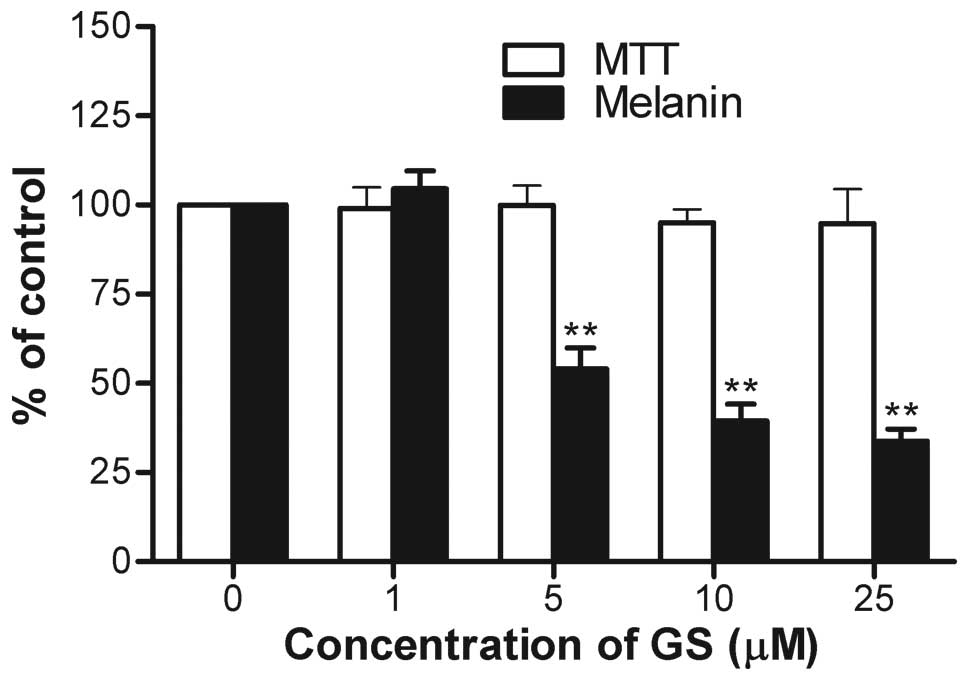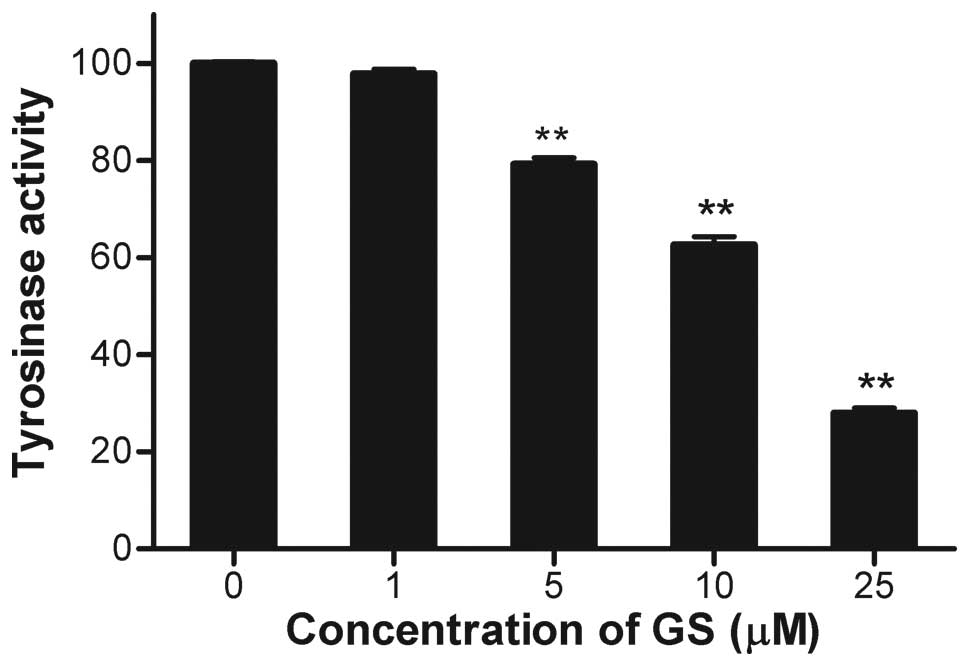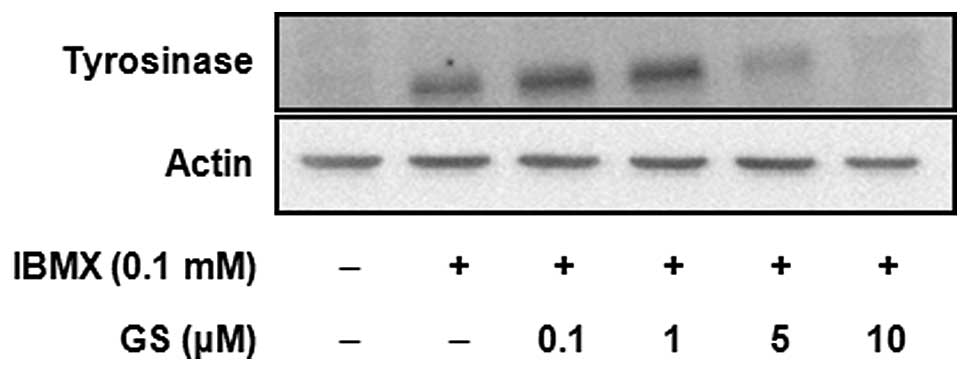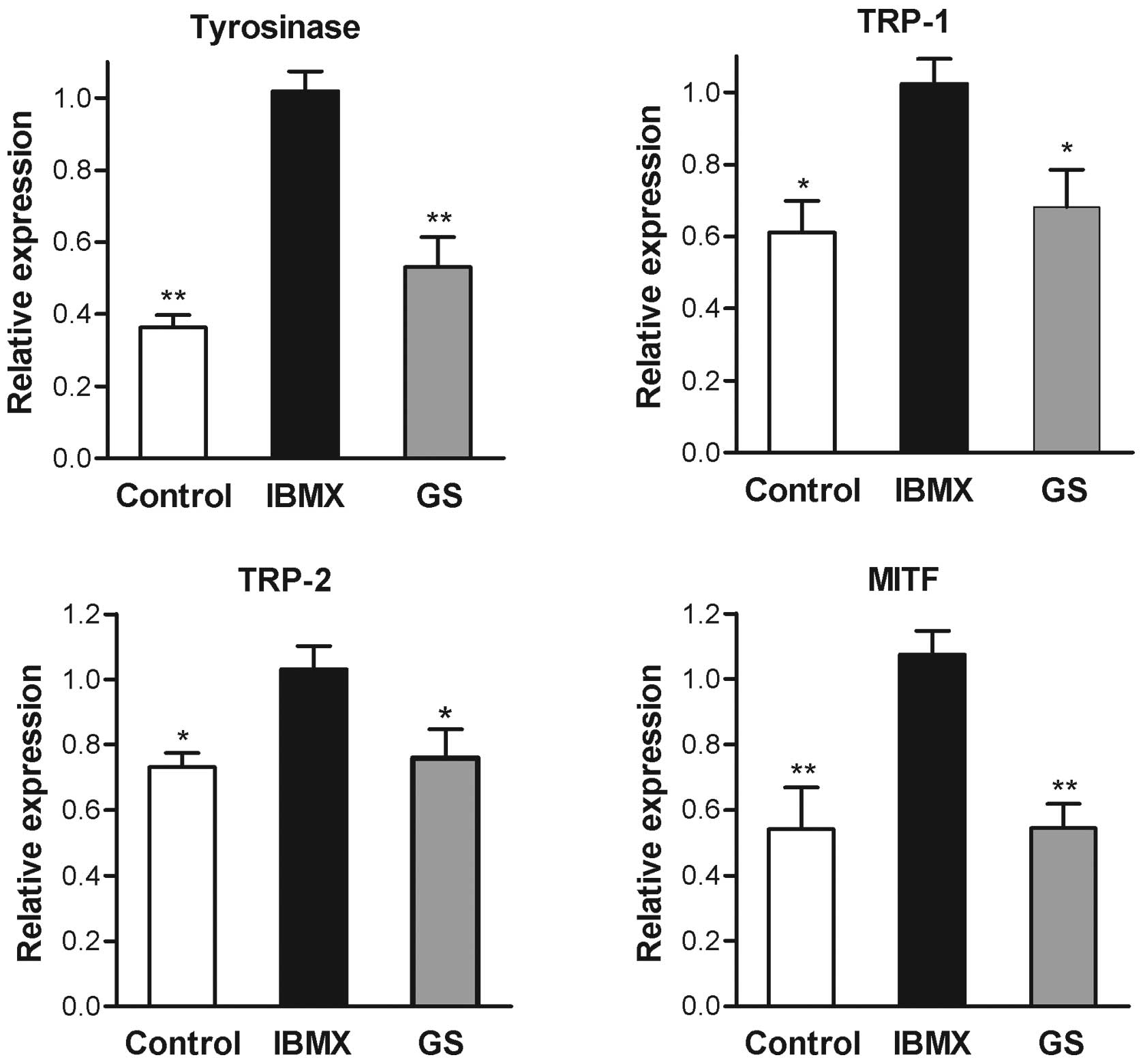Guggulsterone inhibits melanogenesis in B16 murine melanoma cells by downregulating tyrosinase expression
- Authors:
- Published online on: July 12, 2012 https://doi.org/10.3892/ijmm.2012.1057
- Pages: 974-978
Abstract
Introduction
Melanin is synthesized in the melanosomes of melanocytes by a process known as melanogenesis and plays a crucial role in protecting the skin from the harmful effects of ultraviolet (UV) radiation and diverse free radicals. Melanogenesis is regulated by at least three melanogenic enzymes, tyrosinase, tyrosinase-related protein (TRP)-1 and TRP-2 (1). Tyrosinase is a rate-limiting enzyme that catalyzes the first two steps in the melanin biosynthetic pathway: hydroxylation of tyrosine to 3,4-dihydroxyphenylalanine (DOPA) and oxidation of DOPA to DOPAquinone (2). TRP-2, which functions as a DOPAchrome tautomerase, catalyzes the rearrangement of DOPAchrome to 5,6-dihydroxyindole-2-carboxylic acid (DHICA) (3), and TRP-1 oxidizes DHICA to a carboxylated indole-quinone (4).
Understanding the regulation of melanogenesis is of great interest pharmaceutically and cosmeceutically as melanogenesis inhibitors can be used for the treatment of hyper-pigmentation-related diseases, such as melasma, lentigines, nevus, ephelis, freckles and age spots (5). Of the various signaling pathways that regulate melanogenesis, the cyclic AMP (cAMP)-dependent signaling pathway plays a pivotal role. cAMP-elevating agents, such as α-melanocyte stimulating hormone (α-MSH), isobutylmethylxanthine (IBMX) and forskolin stimulate melanogenic processes in the human epidermis (6,7). cAMP increases the expression of melanogenic enzymes partly through protein kinase A (PKA). PKA phosphorylates the cAMP responsive element binding protein (CREB), which induces the expression of microphthalmia-associated transcription factor (MITF) (8). MITF is known as a master regulator of melanocyte development, survival, differentiation and melanogenesis (9). It also regulates the transcription of three major melanogenic enzymes: tyrosinase, TRP-1 and TRP-2.
Flavonoids are a group of polyphenolic compounds widely distributed in plants. Their potent bioactivity and relatively low toxicity have rendered them attractive for use as active ingredients in functional foods and cosmetics. Guggulsterone [4,17(20)-pregnadiene-3,16-dione], which is the active component of gugulipid, is derived from the gum resin (guggulu) of the tree, Commiphora mukul. This gum resin has been used for centuries in Ayurvedic medicine to treat obesity, arthritis and hyperlipidemia (10,11). In addition, guggulsterone has been reported to act as a farnesoid X receptor (FXR) antagonist (12,13). Therefore, it can effectively regulate bile acid synthesis (11–14) and carbohydrate metabolism (15). We have previously studied the effects of guggulsterone on type 1 diabetes (16) and arthritis (17). However, to our knowledge, there is no report on effect of guggulsterone on melanogenesis. During screening for new melanogenesis-inhibiting agents from flavonoids, we found that guggulsterone effectively inhibited melanogenesis. Therefore, in this study, we investigated the inhibitory mechanism of guggulsterone against IBMX-induced melanogenesis in B16 melanoma cells.
Materials and methods
Cells and materials
The B16/F10 mouse melanoma cell line was obtained from the Korean Cell Line Bank (Seoul, Korea). Cells were cultured in DMEM containing 10% fetal bovine serum, 100 U/ml penicillin, 0.1 mg/ml streptomycin, and 0.25 μg/ml amphotericin B at 37°C in a humidified 95% air/5% CO2 atmosphere. Guggulsterone was obtained from Alexis Biochemicals (Lausen, Switzerland), and 6-ethyl chenodeoxycholic acid (CDCA), α-MSH, IBMX, and forskolin were obtained from Sigma (St. Louis, MO, USA). Drug treatment began 24 h after seeding, and cells were harvested after two days of incubation.
Melanin content measurement
The melanin contents of the cultured B16 cells were measured as described previously (18). The cells were washed twice with phosphate-buffered saline (PBS) and lysed with 20 mM Tris-0.1% Triton X-100 (pH 7.5). Cell lysates were precipitated with the same amount of 20% trichloroacetic acid. After washing twice with 10% trichloroacetic acid, the pellets were treated with ethyl alcohol:diethyl ether (3:1) and diethyl ether in succession. The samples were air-dried, dissolved in 1 ml of 0.85 M KOH, and boiled for 15 min. After cooling, absorbance was measured with a spectrophotometer at 440 nm. The amount of cellular melanin was corrected according to the DNA content of the samples. The DNA content was determined using the fluorescence assay of bisbenzimide H 33258 using a DNA Quantification kit (Sigma).
Tyrosinase activity assay
Tyrosinase activity was assayed as DOPA oxidase activity with some modifications, as described previously (18). Briefly, cell lysate was obtained after washing twice with PBS. Tyrosinase activity was then analyzed spectrophotometrically by following the oxidation of DOPA to DOPAchrome at 475 nm. The reaction mixture containing 100 μl of freshly prepared substrate solution (0.1% L-DOPA in 0.1 M sodium phosphate, pH 6.0) and 50 μl of enzyme solution was incubated at 37°C. The absorbance change was measured during the first 10 min of the reaction, while the increase of the absorbance was linear. Corrections for the auto-oxidation of L-DOPA in the controls were made. The tyrosinase activity was corrected according to the DNA content of the samples and presented as a percentage of IBMX-treated control cells.
MTT assay
The viability of the cultured cells was determined by the reduction of 3-(4,5-dimethylthiazol-2-yl)-2,5-diphenyltetrazolium bromide (MTT) to formazan. The cells were seeded in 96-well plates and cultured for 24 h. Following drug treatment, MTT (5 mg/ml in PBS, 100 μl) was added to each well. The cells were incubated at 37°C for 30 min, and dimethyl sulfoxide (100 μl) was then added to dissolve the formazan crystals. The absorbance was measured at 570 nm with a spectrophotometer.
Western blot analysis
Cells were homogenized in ice-cold lysis buffer. The homogenates containing 10 μg of protein were separated by SDS-PAGE with 10% resolving and 3% acrylamide stacking gel and transferred to a nitrocellulose membrane in a western blot analysis apparatus run at 100 V for 1.5 h. The nitrocellulose membrane was blocked with 2% bovine serum albumin and then incubated overnight with 1 μg/ml goat anti-murine tyrosinase IgG (Santa Cruz Biotechnology, Inc., Santa Cruz, CA, USA). The binding of the antibody was detected with anti-goat IgG conjugated with horseradish peroxidase (Sigma). Immunoblots were developed using an Enhanced Chemiluminescence Plus kit (Amersham Biosciences, Buckinghamshire, UK), and the intensity of the bands was measured by LAS-1000 (Fujifilm, Tokyo, Japan).
Real-time RT-PCR
Total RNA was prepared from the cells using TRIzol reagent (Invitrogen, Carlsbad, CA, USA). Total RNA (2 μg) was treated with RNase-free DNase (Invitrogen), and first-strand cDNA was generated using random hexamer primers provided in the first-strand cDNA synthesis kit (Applied Biosystems, Foster City, CA, USA). Specific primers for each gene (Table I) were designed using Primer Express software (Applied Biosystems). The real-time RT-PCR reaction mixture consisted of 10 ng reverse transcribed total RNA, 167 nM forward and reverse primers, and 2X PCR master mixture in a final volume of 10 μl. PCR reactions were carried out in 384-well plates using the ABI PRISM 7900HT Sequence Detection System (Applied Biosystems). All the experiments were performed in triplicate.
Table ISequences and accession numbers for forward (F) and reverse (R) primers used in real-time RT-PCR. |
Statistical analysis
Statistical analysis of the data was performed using ANOVA and Duncan’s test. P<0.05 was considered to indicated statistically significant differences.
Results
Guggulsterone inhibits melanogenesis in B16 cells
In order to investigate the effects of guggulsterone on IBMX-induced melanogenesis, the melanin contents in the B16 cells were measured following treatment with guggulsterone. At concentrations of 1, 5, 10, and 25 μM guggulsterone, melanin production was compared with the untreated controls (Fig. 1). At concentrations of 1, 5, 10, and 25 μM, guggulsterone decreased melanin production to 104.5±5.0, 54.1±5.8, 39.4±4.8 and 33.8±3.4%, respectively in a dose-dependent manner without obvious cytotoxicity at any of the concentrations tested.
Guggulsterone decreases the expression of melanogenesis-related genes
Since tyrosinase is the rate-limiting enzyme for melanin biosynthesis, the effect of guggulsterone on tyrosinase activity was determined. Cellular tyrosinase activity was decreased by guggulsterone in a dose-dependent manner (Fig. 2), which was consistent with the decreased melanin content (Fig. 1). The expression of tyrosinase protein was determined by western blot analysis (Fig. 3). The results showed that the tyrosinase protein was greatly increased by IBMX treatment, and this induction was significantly inhibited by guggulsterone in a dose-dependent manner. The expression of tyrosinase mRNA determined by real-time RT-PCR also exhibited a significant decrease following guggulsterone treatment (Fig. 4). These results indicated that the inhibition of tyrosinase by guggulsterone was exerted at the transcriptional level. The mRNA levels of TRP-1, TRP-2 and MITF, members of the melanogenesis-related gene family, were also decreased by the presence of guggulsterone (Fig. 4).
Guggulsterone inhibits cAMP-elevating agent-induced melanogenesis
When the B16 cells were incubated with IBMX, the cell suspension turned black, indicating increased cellular melanogenesis (Fig. 5). The cellular melanin contents were also markedly increased in the cells treated with 5 μM α-MSH or 5 μM forskolin. However, the presence of guggulsterone significantly inhibited melanogenesis induced by both α-MSH and forskolin (Fig. 5), suggesting that guggulsterone regulates melanogenesis through the cAMP-dependent pathway.
The inhibitory effect of guggulsterone on IBMX-induced melanogenesis was not affected when the B16 cells were treated with both guggulsterone and CDCA, an antagonist and an agonist for FXR, respectively (Fig. 6). These results indicated that the effect of guggulsterone on melanogenesis was not mediated by antagonizing the FXR signaling pathway. Again, treatment with guggulsterone or CDCA alone did not affect melanogenesis at the concentration used in this study.
Discussion
We performed this study to examine whether guggulsterone can be used as a whitening cosmetic agent. To answer this question, we first evaluated whether guggulsterone can inhibit melanogenesis in IBMX-treated B16 melanoma cells. When the B16 cells were treated with guggulsterone, a dose-dependent inhibition of melanin production was observed. This result cannot be explained by the cytotoxicity of guggulsterone, as there was no evident decrease in the number of viable cells up to a concentration of 25 μM.
UV-induced hyperpigmentation occurs in two stages, an immediate darkening and a delayed tanning reaction. Immediate pigment darkening is thought to result from the oxidation of pre-existing melanin and redistribution of melanosomes. By contrast, the delayed tanning response that is photoprotective against subsequent UV injury begins as the immediate pigmentation reaction fades and progresses for at least three to five days after UV exposure (19). Delayed tanning is preceded by the increase in tyrosinase activity in melanocytes (5,19). Since tyrosinase catalyzes the rate-limiting reaction of the melanogenic process, any reduction in the amount of enzyme activity or expression will result in a corresponding decrease in the amount of melanin synthesized. Indeed, in B16 cells treated with IBMX, there were marked increases in tyrosinase activity, namely increases in protein and mRNA expression, which were similar to those of the delayed tanning response after UV irradiation. Accordingly, the treatment of cells with guggulsterone resulted in dose-dependent inhibition of the enzymatic activity and expression of tyrosinase. These results indicate that guggulsterone inhibits IBMX-induced melanogenesis in B16 cells through the suppression of tyrosinase expression.
The melanocyte-keratinocyte complex of the skin responds quickly to a wide range of environmental stimuli, often through paracrine and/or autocrine means. IBMX is known to increase cellular cAMP through the inhibition of the cAMP-degrading enzyme, phosphodiesterase (20). Guggulsterone effectively blocked the IBMX-induced increase in melanogenesis by decreasing the expression of tyrosinase. This effect occurred at the transcriptional level, suggesting its action on the cAMP-dependent pathway. When the B16 cells were treated with α-MSH, a peptide acting on melanocortin 1-receptor (MC1-R) of melanocytes (21), or forskolin, a direct activator of adenylate cyclase (22), the cellular melanin contents were significantly increased. Again, guggulsterone significantly inhibited melanogenesis induced by both α-MSH and forskolin, as in the case of IBMX stimulation. These results also support the action mechanism of guggulsterone on the cAMP-dependent pathway. In addition to the cAMP/PKA pathway, increased melanogenesis after UV irradiation was thought to occur through the activation of the diacylglycerol/protein kinase C (PKC) and nitric oxide/protein kinase G (PKG) pathways, and SOS response to UV-induced DNA damage (5). The PKC-induced activation of tyrosinase occurs through phosphorylation rather than the synthesis of new enzymes (23). However, PKG is known to increase the expression of tyrosinase protein (24). The additional effects of guggulsterone on these pathways require further study.
Safety following long-term application is a very important issue for therapeutic compounds. In recent years, naturally occurring herbal extracts and flavonoids have gained attention as putative hypopigmenting agents (18,25–27). In the case of guggulsterone, no toxicity was observed after oral administration (75 mg/kg) for eight weeks in laboratory rats (28). The topical application of guggulsterone prior to 12-O-tetradecanoylphorbol-13-acetate (TPA) application onto mouse skin resulted in a significant inhibition against TPA-induced skin edema and hyperplasia without any noticeable side-effects (29). In addition, guggulsterone has long been used in traditional medicine. This evidence suggests the possibility of guggulsterone as a safe hypopigmenting agent.
In conclusion, to our knowledge, the present study demonstrates for the first time that guggulsterone is an effective inhibitor of tyrosinase and inhibits melanin biosynthesis. Even though we have not determined its effects in in vivo conditions, guggulsterone may have beneficial effects in the treatment of hyperpigmentation diseases.
Acknowledgements
The present study was supported by a National Research Foundation of Korea grant funded by the Korean Government (no. 2011-0028222).















